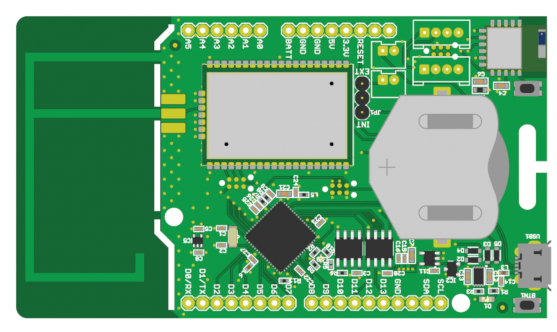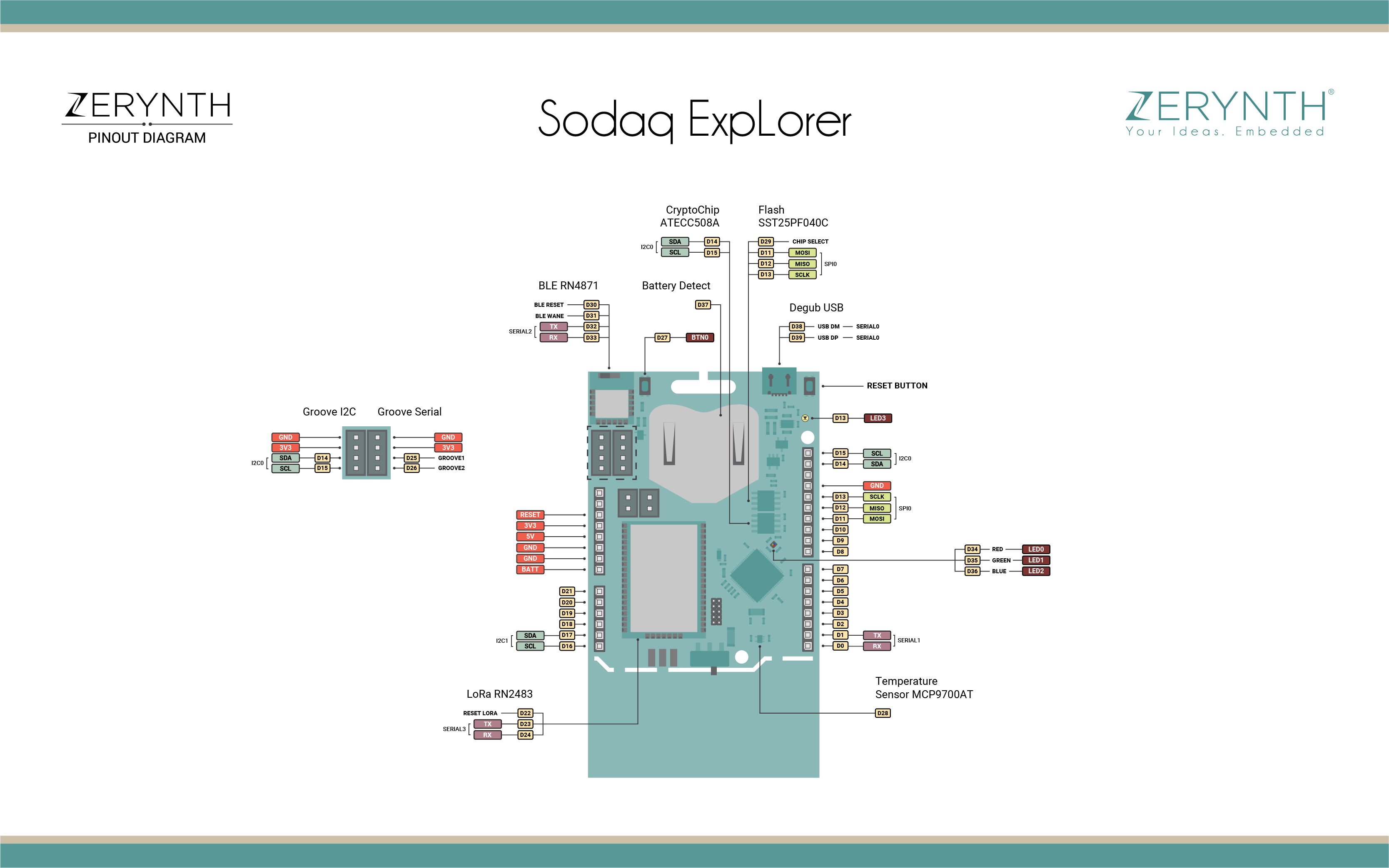SODAQ ExpLoRer¶
The ExpLoRer is a development/evaluation tool based on the Atmel SAMD21J18A ARM Cortex-M0+ CPU. intended for the evaluation of Microchip wireless modules in a Research and Development laboratory environment. It is not a Finished Appliance. Manufacturers who integrate ExpLoRer in a Finished Appliance product must take responsibility to follow regulatory guidelines, for example for CE marking.

Note
All the reported information are extracted from the official SODAQ ExpLoRer page , visit this page for more details and updates.
Pin Mapping¶

SODAQ ExpLoRer Official Schematic, Reference Design and Pin Mapping are available on the official SODAQ ExpLoRer page.
Flash Layout¶
The internal flash of the SODAQ ExpLoRer is organized as a single bank of 256k.
Device Summary¶
- Microcontroller: SAMD21 Cortex-M0+ 32bit low power ARM MCU
- Operating Voltage: 3.3V
- I/O Pins: 20
- Analog Output Pin: 10-bit DAC
- DC Current per I/O pin: 7 mA
- LoRa: Microchip RN2483 module
- Bluetooth: Microchip RN4871 Module
- Cyptochip: ATECC508A
- Temperature sensor: MCP9700AT
- SPIs: 1
- I2Cs: 2
- UARTs: 1
- Flash Memory: 256 KB and 4 MB (External Flash)
- SRAM: 32 KB
- Clock Speed: 48 MHz
Power¶
The SODAQ ExpLoRer can be powered via the USB connector or with a coin cell battery of 3.6V.
The ExpLoRer can run on a battery. By default the ExpLoRer is delivered with a coincell battery. To charge the battery you need to connect an usb and/or solar panel.
The ExpLoRer can only run on one battery at the same time, move the jumper to connect the internal (coincell) or external battery. It will only charge the battery connected with this jumper.
Connect any 3.3v – 5.2v power to the solar connector, this source will charge to battery.
Note
Do not short circuit the Li-Ion coin cell or any of the pins of the ExpLoRer because of risk of heat, smoke, and fire.
Connect, Register, Virtualize and Program¶
To recognize the device, all Windows (automatic driver software installation), OSX and Linux machines will recognize the device as a COM port automatically.
Note
For Linux Platform: to allow the access to serial ports the user needs read/write access to the serial device file. Adding the user to the group, that owns this file, gives the required read/write access: Ubuntu distribution –> dialout group; Arch Linux distribution –> uucp group.
If the device is still not recognized or not working, the following udev rules may need to be added:
# Check SUBSYSTEM
SUBSYSTEMS=="hidraw", KERNEL=="hidraw*", MODE="0666", GROUP="dialout"
# SODAQ ExpLoRer Device
SUBSYSTEMS=="usb", ATTRS{idVendor}=="2341", ATTRS{idProduct}=="824e", MODE="0666", GROUP="users", ENV{ID_MM_DEVICE_IGNORE}="1"
SUBSYSTEMS=="tty", ATTRS{idVendor}=="2341", ATTRS{idProduct}=="824e", MODE="0666", GROUP="users", ENV{ID_MM_DEVICE_IGNORE}="1"
Once connected on a USB port the SODAQ ExpLoRer device is recognized by Zerynth Studio. The next steps are:
- Put the SODAQ ExpLoRer in Virtualization Mode;
- Double click on the RST button;
- Select the SODAQ ExpLoRer Virtualizable on the Device Management Toolbar;
- Register the device by clicking the “Z” button from the Zerynth Studio;
- Create a Virtual Machine for the device by clicking the “Z” button for the second time;
- Virtualize the device by clicking the “Z” button for the third time.
Note
During these operations the MKR1000 device must be in Virtualization Mode. if the device returns in standard mode, it is necessary to put it in DFU Mode again.
After virtualization, the SODAQ ExpLoRer is ready to be programmed and the Zerynth scripts uploaded. Just Select the virtualized device from the “Device Management Toolbar” and click the dedicated “upload” button of Zerynth Studio and reset the device by pressing the Reset on-board button when asked.
Firmware Over the Air update (FOTA)¶
The Firmware Over the Air feature allows to update the device firmware at runtime. Zerynth FOTA in the SODAQ ExpLoRer device is available for bytecode only.
Flash Layout is shown in table below:
| Start address | Size | Content |
|---|---|---|
| 0x00002000 | 94Kb | VM Slot |
| 0x00019600 | 77Kb | Bytecode Slot 0 |
| 0x0002CB00 | 77Kb | Bytecode Slot 1 |
Power Management and Secure Firmware¶
Power Management feature allows to optimize power consumption by putting the device in low consumption state.
Secure Firmware feature allows to detect and recover from malfunctions and, when supported, to protect the running firmware (e.g. disabling the external access to flash or assigning protected RAM memory to critical parts of the system).
Both these features are strongly platform dependent; more information at Power Management - Microchip SAMD21 section and Secure Firmware - Microchip SAMD21 section.
Missing features¶
Not all features have been included in the SODAQ ExpLoRer support. In particular the following are missing:
- Bluetooth support